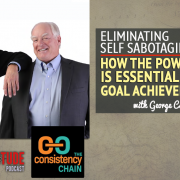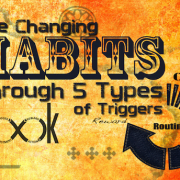George Campbell & Jim Packard – Eliminating Self Sabotaging Behavior: How the Power of Habit Is Essential to Goal Achievement (AoL 193)
Self sabotaging behavior is a common theme when it comes to personal and business development (or the lack thereof). Whether it’s the lack of willpower to get healthier, the determination it takes to go through college, or the focus it takes to build one’s business, there’s one thing that is certain when it comes to accomplishment: setting a goal is one thing – but actually achieving that goal is something completely different.
In this session of the show, Ya’el Johnson and I get to talk to two completely different kinds of individuals who have made it their passion to help others figure out how to achieve goals like this.
Through their app called the Consistency Chain, they’re helping tons of people build good habits in place of the ones that have lead them to where they are now.
In their recent book built on the same premise, The Consistency Chain for Network Marketing, authors George Campbell & Jim Packard suggest that the main reason that people don’t do well with network marketing is that they simply haven’t built the right habits to actually grow their business. Interestingly, George goes on to say that he was only successful when he realized he was the common denominator between all these opportunities.
In this conversion, we explore how they came to that conclusion and some of the concepts one should consider when trying to achieve anything in this world – let alone building a network marketing business!
Enjoy!
SPECIFICALLY, YOU’LL FIND OUT MORE ABOUT:
- As enthusiasts of the industry, how did George and Jim get into Network Marketing initially? 12:55
- How do you know when you’re working with the right business when it comes to network marketing? 21:18
- How did Jim & George realize they were on to something when they felt the 80/20 rule applies to those who are successful in network marketing? 26:24
- How do they give themselves milestones on a regular basis to keep them going in their journey? 30:17
- What are some of the ways that people are using the Consistency Chain app in their daily lives? 37:17
- What are some of the things George and Jim are looking forward to moving forward in 2021? 42:10
- Who are Jim and George’s personal influencers and teachers? 45:23
- What’s the biggest plot twist they’ve seen in their day to day life? 48:43
- Is there a particular gift they like giving others? 50:31
- What is something they’ve become good at saying no to? 52:33
- How does someone realize they’re living their own personal mission? 53:59
ITEMS and PEOPLE MENTIONED IN THIS EPISODE:
George and Jim Online: Website, Facebook, LinkedIn
Cohost: Ya’el Johnson
Powered By: Groove Funnels – Join Us in Exploring the power of this awesome new tool! (Get started free today!)
Marshmallow Test
Seinfeld
Jay Abraham – Getting Everything You Can Out of All You Got (Amazon Link)
Jim Rohn
Dale Carnegie
Right click here and save-as to download this episode to your computer.
SHOW NOTE EXTRAS:
Joe Malarkey at the United States Bowling Congress’ Event
Joe Malarkey on Customer Service
Tom Chenault interviews Jim and George (MLM Application)
Margo Lovett and Deborah Thorn interview Jim and George (Traditional Business Application)
Thanks for Listening!
Thanks so much for joining us again this week. Have some feedback you’d like to share? Leave a note in the comment section below!
If you enjoyed this episode, please share it using the social media buttons you see at the top of the post.
Also, please leave an honest review for The AoL Podcast on iTunes! Ratings and reviews are extremely helpful and greatly appreciated! They do matter in the rankings of the show, and we read each and every one of them.
If you have any questions feel free to email them over via the email mentioned in the show or by our contact form.
And finally, don’t forget to subscribe to the show on Castbox, iTunes, Stitcher, PodBean, and/or Google Play Music. It’s absolutely free to do so.
A huge thank-you to you guys for joining us!
Cheers!




